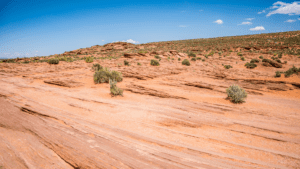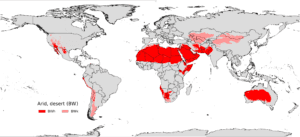
Introduction
Climate is the average weather condition at a specific place over a long period. The classification of climates of the world is done to understand how the different climatic elements form combinations in different parts of the world. Wladimir Koppen(1846-1940), a Russian-born German climatologist and botanist, attempted the classification of world climate. The following article is thus about the Koppen Climate classification.
Significance
Koppen climate classification is significant in understanding the world’s climatic patterns. A few significances are
- It enables easy comparison of climates worldwide.
- Helps in predicting the types of vegetation and ecosystems that thrive in different climates.
- Farmers use the Koppen classification to make informed decisions about crop selection and land use.
- Urban planners consider climate classifications while designing infrastructure and buildings to ensure safety.
- It serves as an educational tool in geography and environmental studies.
Koppen Climate classification
The main categories under the climatic classification of Koppen are:
1. Tropical climate
These climates are commonly found in the tropical belt of both hemispheres. Warm climates with 18°C temperature and above throughout the year. Precipitation is high, and there is no winter. There are 3 subdivisions:
Af (Tropical rainforest climate)
- Rainfall is present throughout the year.
- The average precipitation is 60mm every month.
- Because of hot and wet conditions throughout the year, tropical rainforests occur in this part.
- This type of climate is experienced over the Amazon basin, the Zaire basin, and South-East Asia.
Am (Tropical monsoon climate)
- It has a short and dry season.
- Precipitation is less than 60mm in the driest month.
- Rainfall occurs excessively during the summer rainy season, making the land surface moist throughout the year.
- It supports the growth of dense forests, which shed leaves in the dry season.
- It is typical of the monsoon climate.
- Found in Abidjan (Ivory Coast), Jakarta(Indonesia), Yangon (Myanmar), and Chittagong (Bangladesh).
Aw or As (Tropical wet and dry or Savanna climate)
- This type of climate is known as a tropical savanna or grassland.
- Both winter and summer are dry.
- The amount of precipitation in the driest month is less than 6 cm.
- Tall grasses with scattered trees around are a common sight in this type of climate.
- Found in Dar es Salam (Tanzania), Darwin (Australia), Ho Chi Minh City (Vietnam), Mumbai and Chennai (India), and Dhaka (Bangladesh).
2. Dry climate
This type of climate is characterized by a scarcity of moisture. There are four subdivisions:
Bwh (Desert or low latitude climate)
- These are low-latitude hot deserts.
- Atmospheric conditions are hot and dry.
- The average annual temperature is above 18°C.
- Found in the southwest USA, North Africa, West Asia, the Thar desert, and central Australia.
Bwk (Mid-latitude desert)
- These are mid-latitude cold deserts.
- Atmospheric conditions are cold and dry.
- The average annual temperature is below 18°C.
- Prevails in TaklaMakan (China), and the Gobi desert (Mongolia).
Bsh (Semi-arid climate)
- These are semi-arid tropical steppe climates.
- The average annual temperature is more than 18°C.
- Rainfall is less than 30cm.
- Found in Odessa (USA), Niamey (Niger), and Lahore (Pakistan).
Bsk (Steppe climate)
- These are temperate steppe climates.
- Average temperature is less than 18°C.
- Also found near cold deserts.
- Baku (Azerbaijan), Denver (USA), Lhasa (China) and Ulaanbaatar (Mongolia).
3. Warm-temperate climate
This type of climate is characterized by meso-thermal conditions. The mean temperature of the coldest month is below 18°C but above -3°C, and the warmest month is above 10°C. Both winter and summer are present. The subtypes are
a. Cfa (Humid subtropical or China type climate)
- These are subtropical wet climates. Precipitation occurs throughout the year.
- Long and hot summer season.
- The winter season is short and not too chilly.
- The average temperature of the hottest month is 22°C.
- Buenos Aires (Argentina), Shanghai (China), Osaka (Japan), and Srinagar (India) are prime examples.
b. Cfb (Marine west european climate)
- It is a temperate marine climate with adequate precipitation in all seasons.
- The average summer month temperature is less than 22°C, whereas the winter temperature is above 0°C.
- Paris(France), Amsterdam(Netherlands), Port Elizabeth(South Africa), and Melbourne(Australia) are examples of the climate.
c. Cs (Mediterranean climate)
- The mean temperature during summer is 20°C- 27°C.
- Summers are warm and dry. During winter, the temperature is 4°C to 10°C.
- Winters are mild and experience rainfall between 40 cm and 60 cm.
- Experienced over central California, central Chile, Mediterranean region, southern South Africa, southeastern and southwestern Australia.
4. Cold snow forest climate
This type of climate has severe winters, where the mean temperature of the coldest month is below -3 °C and the warmest month is above 10 °C. The subtypes are
a. Df (Cool east coast climate)
- Summers are hot and humid under the influence of tropical air masses.
- The mean temperature is 25°C. Winters are cold with a mean temperature between -4°C-0°C.
- Precipitation is variable.
- Found in the north-eastern USA, the lower Danube plains, Korea, Japan, and Northern China.
b. Ds (Taiga climate)
- Summers are short with mean temperatures between 10°C and 15°C.
- Winters are long and cold, with temperatures going to -50°C in some areas.
- Precipitation is low but sufficient for plants.
- Experienced over the belts of Alaska to Newfoundland and from Norway to the Kamchatka peninsula in the subarctic.
c. Dw (Continental type climate)
- Summers are short and cool with a mean temperature ranging from 10°C to 21°C.
- Winters are long and cold with mean temperatures below 0°C.
- Rainfall is variable. Snowfall occurs during winter.
- Found in Poland and the Baltic states, the Russian plains, the Northern states of the USA, and the southern states of Canada.
5. Polar climate
This type of climate is the coldest. The temperature of the warmest month is below 10 °C. There is no warm season. The subtypes are-
a. ET (Tundra climate)
- It is characterized by a short summer season.
- The warmest month’s temperature is less than 10°C.
- Winters are cold and long.
- Experienced over the coastal fringes of the Arctic Ocean, and only in the northern hemisphere.
b. Ef (Polar ice cap climate)
- Experienced in extremely high altitudes on mountains.
- The average temperature in summer is below 0C.
- Permanent snow cover inhibits any plant growth.
- Occurs in Antarctica and inner Greenland.
6. Highlands climate
- Temperature variations occur with increasing altitudes.
- Windward sides of mountains may experience higher precipitation.
- Vegetation depends on the altitude of the mountains.
- This type of climate is found over the Rockies, Andes, Alps, and the Himalayas.
Arid climate

Introduction
Arid climate is characterized by low precipitation, high temperature, and barren landscapes.
Definition
Arid climate, also known as desert climate, is a dry climatic subtype in which there is an excess of evaporation over precipitation. Arid climate zones cover 14.2⁒ of the Earth’s land area. Hot deserts are the second most common type of climate on Earth after polar climates.
Arid or desert climate is mentioned prominently in the Köppen climatic classification as Bwh and Bwk sub-type climates.
Characteristics
The major characteristics of an arid climate are pointed out below-
- Extremely low precipitation (less than 250 mm) annually.
- High temperature during the day (annual range of temperature is 40°C)
- Winters are generally cold with temperatures below 10°C.
- The soil type is rocky, sandy, and barren.
- Due to less precipitation, minimal vegetation is found.
- Flora and fauna are limited and adaptive because of the harsh weather.
Types
There are two major variations in describing the types of arid climate.
a. Based on aridity.
b. Based on the climatic zone.
a. Based on aridity
Three subtypes can be found under this category: they are-
Hyper-arid zone
- It covers 4.2% of the world’s area.
- Its aridity index is 0.03.
- Comprises dryland areas without vegetation except a few shrubs.
- Nomadic pastoralism is practiced by local people.
- Annual precipitation is low, not exceeding 100 mm.
Arid zone
- It covers 14.6% of the world’s area.
- Aridity index is 0.03-0.20.
- No farming can be done here except for irrigation.
- Few grasses, shrubs, and small trees are part of the vegetation.
- Rainfall ranges from 100-300mm.
Semi-arid zone
- It covers 12.2% of the world’s total area.
- Aridity index is 0.20-0.50.
- Supports rain-fed agriculture.
- Native vegetation is represented by a variety of species, like grasses, plants, trees, etc.
- Annual precipitation ranges from 400-700 mm.
b. Based on the climatic zone
Mediterranean climate
- The rainy season is during autumn and winter.
- Summers are hot with no rain.
- Winter temperatures are mild.
Tropical climate
- Rainfall occurs during summer.
- The greater the distance from the equator, the shorter the rainy season.
- Winters are long and dry.
Continental climate
- Rainfall is distributed evenly throughout the year.
- Summers have rainfall.
- Winters are not very cold and long.
Geographical distribution
A desert climate or arid climate is often found around 15° to 30° latitude in both the Northern and Southern hemispheres.
The distribution is of the following types
- North America- Sonoran desert, Mojave desert.
- South America- Atacama Desert.
- Africa- the Sahara desert, the Kalahari desert.
- Asia- Arabian desert, Thar desert, Gobi desert.
- Australia- Great Victoria Desert.
- Middle East- Iranian plateau desert.

Human adaptation in an arid climate
Human adaptation in an arid climate has various strategies, some of which are
-
Water conservation
Efficient water conservation practices like usage of drip irrigation, rainwater harvesting etc, are very important for sustaining agriculture and meeting daily needs.
-
Nomadic lifestyle
Maximum communities residing in arid areas adopt a nomadic lifestyle, which allows them to move from place to place in search of water and grazing land for livestock.
-
Housing
Construction of traditional desert huts with materials like stone, mud provides insulation against extreme temperatures.
-
Clothing
Loose-fitting and light- colored clothes help to stay cool in high temperatures, as they protect against the rays.
Fauna of arid climate and their special adaptation
Arid climate has some special types of animals. They are-
- Camels
- Kangaroo rats
- Desert foxes
- Fennec foxes
- Scorpions
- Rattle snakes
They have some unique strategies to adapt to the climate. They are mentioned as
-
Water conservation
Animals like camels can go without water for a longer time and tolerate dehydration because of the lack of water bodies in the surroundings.
-
Camouflage
Many desert animals have evolved coloration and patterns that help them to camouflage in their surrounding, thus helping them to avoid predator attacks or ambush prey.
-
Heat tolerance
Certain species of animals, like lizards and snakes, have heat-enabling features that help them to withstand the tremendous heat during the day.
-
Migration
Some desert animals follow seasonal migrations to different locations with water sources and a supply of food.
-
Nocturnal pattern
Animals like kangaroo rats and foxes are nocturnal, which minimizes their daytime activity during the hot daytime, thus helping them to avoid sweating and face energy or hydration loss.
Flora of arid climates and their special adaptation
There is a very limited amount of fauna in arid climates. They are-
- Cactus
- Succulents
- Shrubs
- Palms
- Wild flowers
- Small trees.
They have some unique strategies to cope with the tremendous temperature. They are as follows-
- Deep-rooted systems:- Arid flora develop extensive and deep root systems, which maximize their ability to obtain groundwater.
- Succulence:- Desert flora stores water in special tissues like fleshy stems or leaves, which allows them to withstand huge periods of drought.
- Less leaf surface:- Some arid plants minimize their leaf surface area, which helps to decrease transpiration and conserve water.
- Halophytes:- In saline environments like arid climate water sources contain high levels of salt, and plants known as halophytes have adapted to tolerate such conditions.
https://en.wikipedia.org/wiki/Desert_climate
https://www.fao.org/3/t0122e/t0122e03.htm
Difference between arid and semi-arid climate
Arid climate |
Semi-arid climate |
|
|
|
|
|
|
|
|
